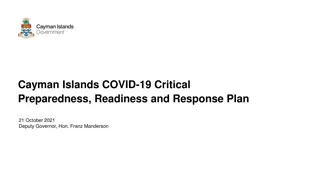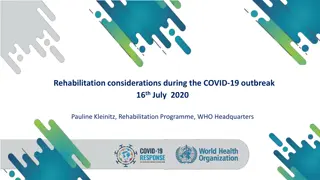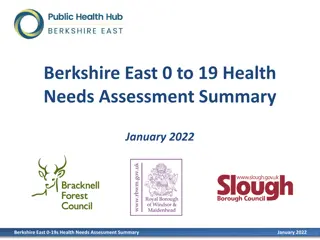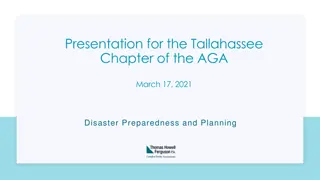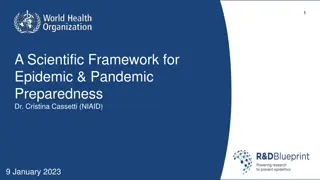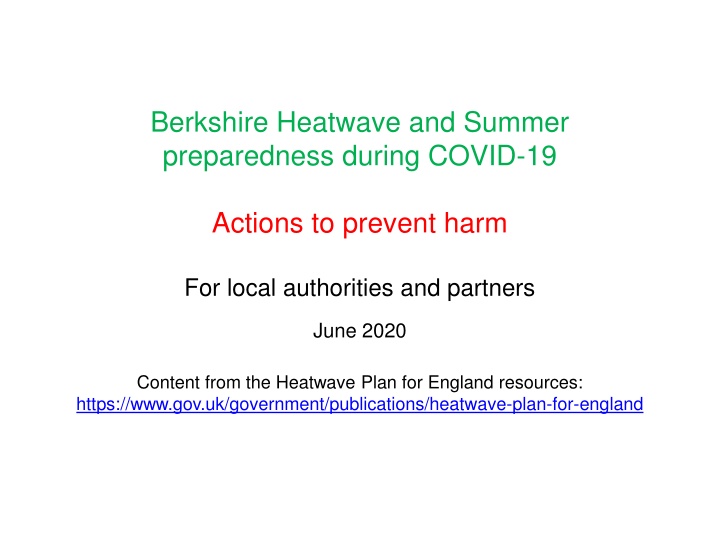
Berkshire Heatwave and Summer Preparedness: Key Contacts and Resources
"Discover key contacts for advice on heatwave preparedness in Berkshire, including email addresses for local councils. Learn why heatwave planning is crucial, with insights on heat-related deaths and health impacts. Access the Heatwave Plan for England resources for essential guidance during COVID-19. Stay informed and take actions to prevent harm during hot weather."
Download Presentation

Please find below an Image/Link to download the presentation.
The content on the website is provided AS IS for your information and personal use only. It may not be sold, licensed, or shared on other websites without obtaining consent from the author. If you encounter any issues during the download, it is possible that the publisher has removed the file from their server.
You are allowed to download the files provided on this website for personal or commercial use, subject to the condition that they are used lawfully. All files are the property of their respective owners.
The content on the website is provided AS IS for your information and personal use only. It may not be sold, licensed, or shared on other websites without obtaining consent from the author.
E N D
Presentation Transcript
Berkshire Heatwave and Summer preparedness during COVID-19 Actions to prevent harm For local authorities and partners June 2020 Content from the Heatwave Plan for England resources: https://www.gov.uk/government/publications/heatwave-plan-for-england
Contents Key contacts for advice Heatwave Plan for England Why is heatwave planning important? Heat-Health Watch alert service Heat and COVID-19 Action tables from Heatwave Plan for England Key public health messages Links to guidance and resources
Key contacts for advice Organisation Email address Bracknell Forest Council Public Health Katherine.Davies@bracknell-forest.gov.uk Cynthia.Folarin@bracknell-forest.gov.uk Royal Borough of Windsor and Maidenhead Council Public Health holli.dalgliesh@rbwm.gov.uk Slough Borough Council Public Health timothy.howells@slough.gov.uk Reading Borough Council Public Health Yasmine.illsley@reading.gov.uk West Berkshire Council Public Health catherine.greaves@westberks.gov.uk april.peberdy@westberks.gov.uk Wokingham Borough Council Public Health mustafa.kamara@wokingham.gov.uk Shared Public Health Team for Berkshire Jonas.Thompson-McCormick@bracknell- forest.gov.uk Chris.Barrett@bracknell-forest.gov.uk
Heatwave Plan for England The Heatwave Plan for England becomes operational between 1stJune and 15thSeptember to raise both public and professional awareness of the health impacts of hot weather, including severe heat. The Heatwave Plan for England provides guidance to NHS, social care and local authorities on how to prepare for and respond to a heatwave which can affect everybody s health, but particularly the most vulnerable people in society.
Why is heatwave planning important? There are around 2,000 heat-related deaths per year in the UK Death rates rise soon after temperature increases, with many deaths occurring in the first two days The impact of heat on mortality is not reflected in admissions, supporting the idea that many heat-related deaths occur before people come to medical attention This emphasises the importance of long-term year round planning actions by LA and Health sector 1 in 5 homes in England are prone to overheating; few (~ 1-3%) have air conditioning A range of mild to severe health impacts can result from exposure to high temperatures The main causes of illness and death during a heatwave are exacerbation of respiratory and cardiovascular illness
Heat-Health Watch alert service Heat-Health Watch alerts are cascaded to a wide range of partners. There are five levels: Long-term planning All year Level 0 Heatwave and Summer Preparedness programme - 1st June 15thSeptember Heatwave is forecast Alert and readiness 60% risk of heatwave in the next 2 3 days Heatwave Action - Temperature reached in one or more Met Office National Severe Weather Warning Service regions Major incident Emergency response Central Government will declare a Level 4 alert in the event of severe or prolonged heatwave affecting sectors other than health Level 1 Level 2 Level 3 Level 4 The triggering threshold temperatures for South East England are 310C by day and 160C by night. The distribution list for the Heat-Health Watch alerts is managed by the Met Office. For new registrations contact enquiries@metoffice.gov.uk Existing users need not re-register.
Headlines COVID-19 amplifies the risks of hot weather Fear of COVID-19 should not prevent action to tackle the risks from hot weather and heatwaves It is critical that actions to prevent health harms from high temperatures continue, with necessary adaptations in line with coronavirus guidance to keep everyone safe (i.e. shielding and self-isolation advice) Fans: In home: do not use a fan if anyone in the home is unwell with symptoms of coronavirus (COVID-19) Care homes: fans should only be used in single rooms for residents who do not have COVID-19 and have not been a close contact of a confirmed case Our care homes and domiciliary care are particularly stretched due to COVID-19, and workforce planning is essential in order to continue to protect those who are dependent on others during a potential heatwave.
Potential risks Potential increase in adverse outcomes amongst the same population groups affected by both high temperatures and COVID-19. For example, older people and those with comorbidities such as cardio-respiratory diseases Increase in exposure to indoor overheating due to COVID- 19 restrictions. For example, people who have been advised to stay at home Reduced access to cool public spaces for respite due to COVID-19 restrictions System-level risks related to concurrency of impacts. For example, increased demand on social care services to prevent both heat and COVID19 related harms
Individual vulnerability (1) EVERYBODY can be affected by high temperatures, but there are certain factors that increase an individual s risk during a heatwave. These include: Older age: especially those over 75 years old, or those living on their own and who are socially isolated, or those living in a care home Chronic and severe illness: including heart or lung conditions, diabetes, renal insufficiency, Parkinson s disease or severe mental illness Inability to adapt behaviour to keep cool: babies and the very young, having a disability, being bed bound, consuming too much alcohol, having Alzheimer s disease Environmental factors and overexposure: living in a top floor flat, being homeless, activities or jobs that are in hot places or outdoors and include high levels of physical exertion Other risk groups: older carers; tourists; people attending large events; people fasting over Ramadan N.B. Although BAME people are not at increased risk per se, significant numbers of people from BAME communities live in urban areas and so may be adversely affected by the urban heat island effect
Individual vulnerability (2) We still have much to learn about how coronavirus (COVID-19) affects the body, but both heat and COVID-19 infections put a strain on the heart and lungs, the kidneys and are linked with inflammation in the body. Clinical vulnerabilities that have been linked with worse outcomes from COVID-19 that are also risks for heat related harms are: High blood pressure Chronic obstructive pulmonary disease Heart and lung conditions (cardiovascular disease) Conditions that affect the flow of blood in the brain (cerebrovascular disease) Kidney disease
Environmental risks Environmental risk factors for increased exposure to heat include: Living in urban areas This is due to the urban heat island effect and is important for those with limited green space nearby Dwelling types prone to overheating Such as south-facing top-floor flats Local air pollution (i.e. particulate matter) may exacerbate the health impacts of heat
Indoor overheating Many more people will be at home this summer To reduce the transmission of coronavirus (COVID-19) many people be will be working from home Anyone with symptoms of COVID-19 will need to stay at home for at least 7 days, others may be advised to stay at home if they have been in close contact with someone who has COVID-19 or they are living in the same household as someone with COVID-19 People who are extremely clinically vulnerable have been advised to limit their contact with others and to stay at home to limit their risk Latest Government advice can be found here: https://www.gov.uk/coronavirus
Higher risk groups Specific populations at increased risk of exposure to heat due to the context in which they live include: Homeless people (whether sleeping rough or in shelters) People resident in specific institutional settings (e.g. prisons, barracks, inpatient psychiatric units) Some occupations, workplaces and schools - particularly those involving significant manual exertional, heat generation (e.g. cooking, some manufacturing roles) and in buildings prone to overheating and without air conditioning. Many of these settings have restrictions in place to reduce COVID-19 transmission additional considerations will be needed to ensure that plans are in place should a heatwave occur
Action tables from Heatwave plan for England Public Health England states the following action tables in the Heatwave Plan for England should continue to be followed with some additional considerations to mitigate and manage the concurrent COVID-19 risks
Action table for commissioners of health and social care (all settings) and Public Health
COVID-19: additional actions for commissioners of health and social care (all settings) and Public Health Work with partner agencies, providers and businesses to raise awareness about the concurrent risk of hot weather and COVID-19 Encourage partners to sign up to the heat-health alert system Ensure care homes and hospitals are aware of the heatwave plan and are preparing for heatwave as a concurrent risk with COVID-19 Engage the community and voluntary sector to support communities to help those most at risk, especially those who are socially isolated Ensure other institutional establishments (i.e. prisons, schools) are aware of heatwave guidance Work with local partners to facilitate equitable and flexible access to green public spaces during hot weather
COVID-19: additional actions for providers of health and social care staff in all settings (community, hospitals and care homes) More residents of care homes and people receiving personal care than usual may be at risk from heat due to COVID ill-health and COVID restrictions. Review who may be at high risk People receiving care may need additional support to cope with the hot weather. Review your usual plans for surge capacity in hot weather in light of possible COVID-19 related staff absence and to ensure staff welfare Communicate alerts to staff and ensure they know what to do when the weather gets hot use the PHE COVID-19 Beat the Heat leaflet and checklist for Care Homes (page 2) Care home managers may wish to remind staff that face masks should be changed when they get damp, staff may need to change their masks more often in hot weather Fans should only be used in single rooms for residents who do not have COVID-19 and have not been a close contact of a confirmed case
Action table for community and voluntary sector and individuals
COVID-19: additional actions for community and voluntary sector and individuals Have plans in place to be able to check on others safely in advance of the hot weather (i.e. over the phone) Follow the advice on the PHE resource Coping with heat and COVID-19 Encourage those who may find it more difficult to cope in hot weather to request help through the volunteer networks, for example, https://www.goodsamapp.org/home Advise those at risk that they should continue to seek medical help if they are feeling unwell and that plans are in place to deliver services safely despite COVID-19
Guidance and resources For everyone: Beat the Heat: Coping with heat and COVID-19 (poster) Beat the heat: Coping with heat and COVID-19 (leaflet) Beat the heat: keep cool at home (checklist) Heatwave Plan for England: easy read version Specific advice and guidance on coronavirus (COVID-19) For care homes and domiciliary care: Beat the Heat Keep residents safe and well during COVID- 19 including a checklist for staff in on page 2 Advice for care home managers and staff: supporting vulnerable people before and during a heatwave
Guidance and resources For health and social care professionals: Advice for health and social care professionals: supporting vulnerable people before and during a heatwave For schools, early years settings and professionals (school nurse, community health practitioner, family health visitor): Looking after children and those in early years settings during heatwaves: guidance for teachers and professionals
NHS summer health advice Heatwave: how to cope in hot weather Hydration leaflet and poster How to get vitamin D from sunlight Sunscreen and sun safety Stay gas safe this summer Water safety for children and young people Window safety for children








